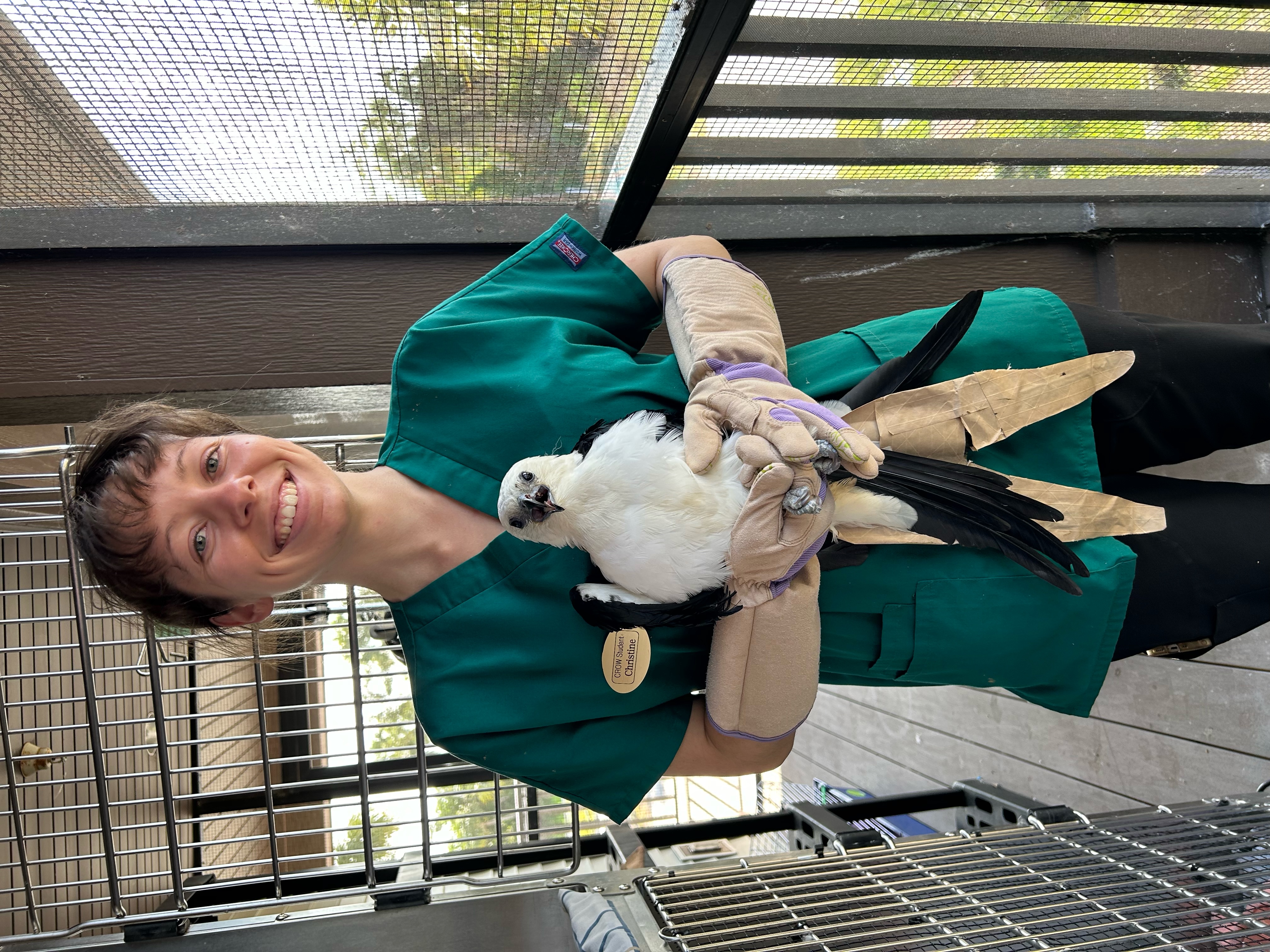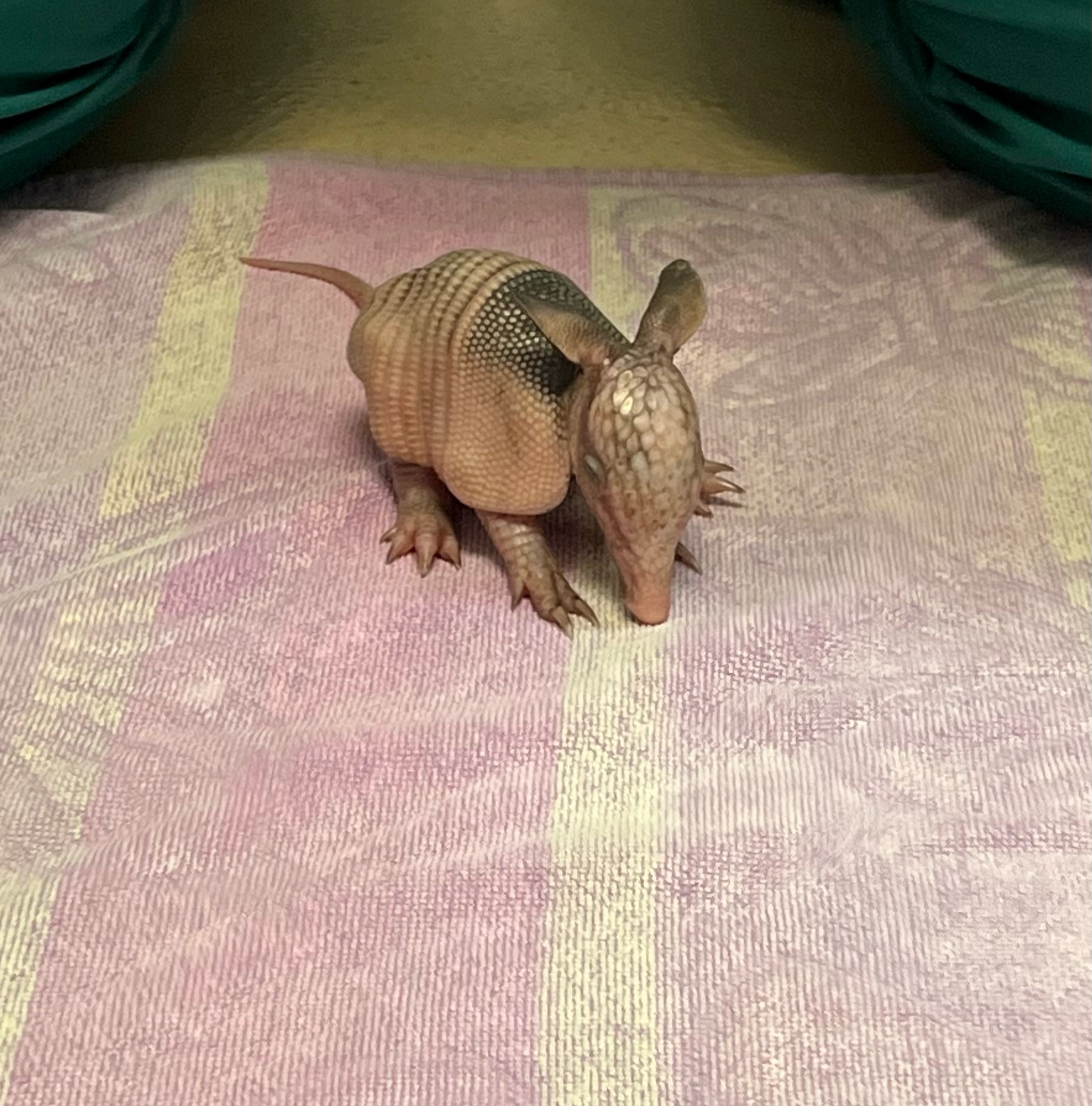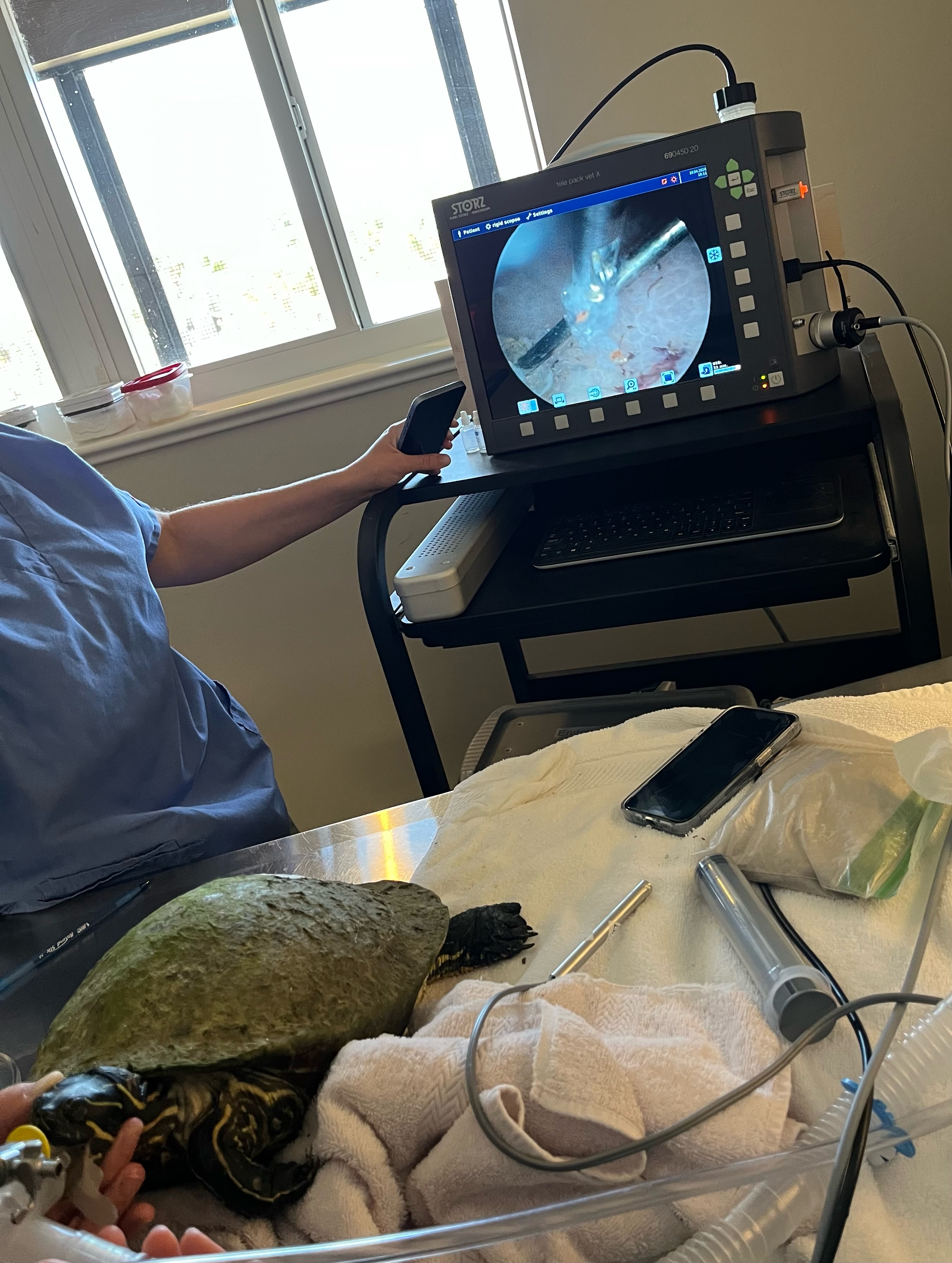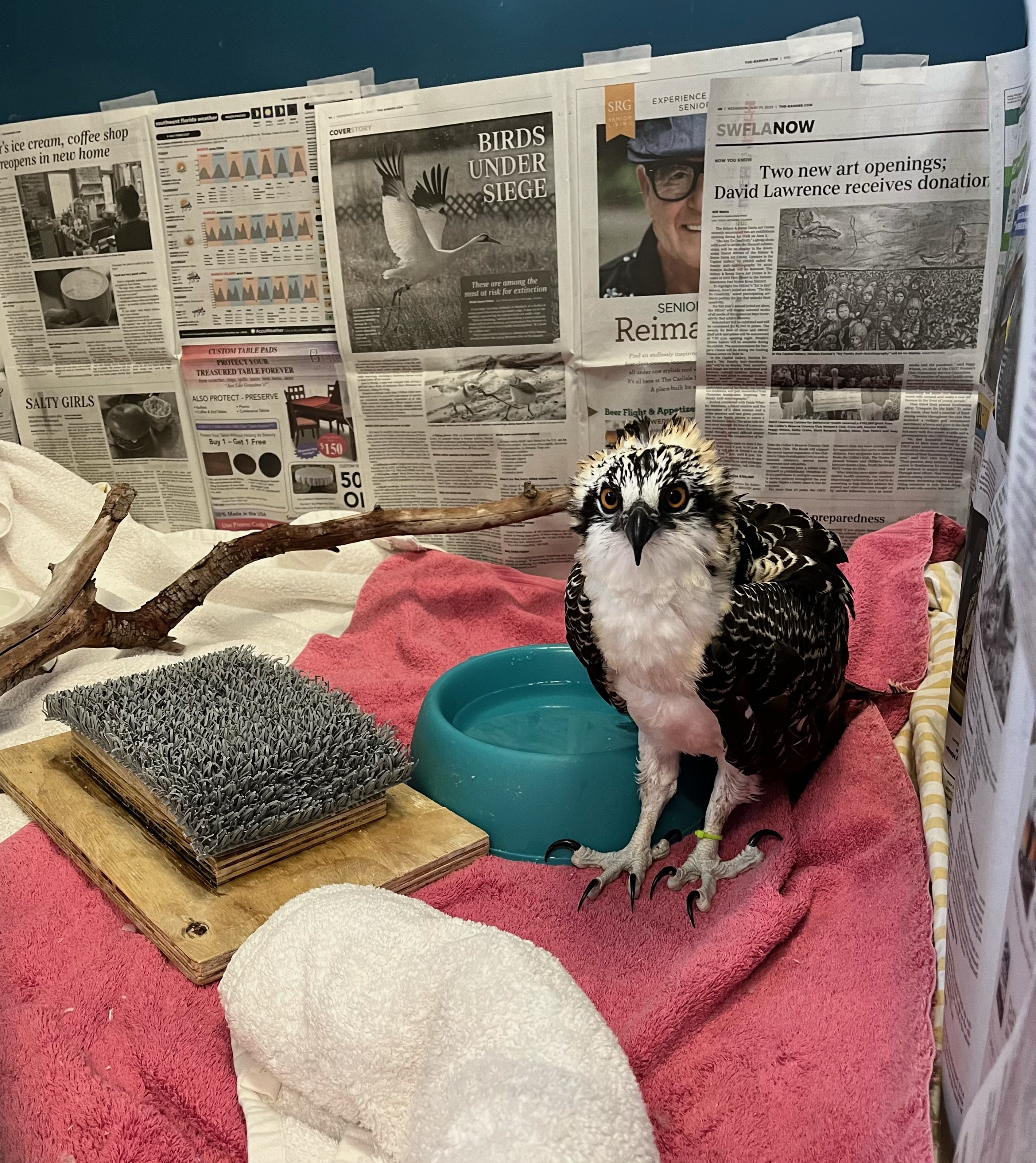Cawing for Wildlife: My Veterinary Medicine Externship at CROW
By Christine Roviera, Cornell DVM ‘25
I have always been passionate about wildlife conservation and have been pursuing that career path throughout my veterinary studies. I have used most of my school breaks to go abroad and gain clinical experiences working with a variety of endangered species (notably in South Africa, Costa Rica and my most recent trip to Namibia). Before starting my fourth and final year of clinical rotations at the Cornell University College of Veterinary Medicine, I wanted to experience a different, more local side of conservation by working at a wildlife rehabilitation hospital in a domestic setting. From testimonies of previous Cornell veterinary externs, I learned about the Clinic for Rehabilitation of Wildlife (CROW), a renowned non-profit teaching hospital and visitor education center.
CROW’s state-of-the-art hospital facilities notably features multiple ICU rooms, a surgery room, radiography and laboratory areas, as well as multiple outdoor enclosures for the rehabilitation of a variety of species; unfortunately, most of the outdoor enclosures are still in the process of being rebuilt, after being destroyed by Hurricane Ian in 2022. Despite having suffered from this devastating natural disaster, the hospital itself admits over 6,000 patients a year, including more than 200 different species of birds, mammals and reptiles. Having never been exposed to wildlife rehabilitation before, I knew that I would learn a lot during my time at CROW and this is why I ended up on beautiful Sanibel Island, Florida, for a five-week long veterinary medicine externship.
A “Typical” Day as a Veterinary Extern
My workday would start at 7am with prepping the in-patients’ medications and administering their morning treatments, weighing them, cleaning their enclosures, and so on. That’s also when the veterinarians would do any required patients’ checks or conduct further diagnostics and/or perform surgeries. CROW mostly sees bird patients (ranging from tiny songbirds to large seabirds such as double-crested cormorants or raptors like great-horned owls), and I really enjoyed putting all the theory that I had learned in my classes (such as comparative anatomy) into practice. Since this was my first time being exposed to wildlife rehabilitation, I had to start from learning the basics like how to safely handle each species, what their husbandry and nutritional requirements are during indoor care and rehabilitation, and how to tube feed critically-ill patients (which, as you can imagine, requires very different techniques between a blue jay and a brown pelican). I honed my skills on injecting medications and administering subcutaneous fluids in avian and reptile species. I learned where to give intravenous injections and how to place catheters, how to apply bandages, do fundic exams and use fluorescein stains, how to take radiographs (and what views to use), and got some practice conducting necropsies.
Later in the morning, I would take care of our reptile patients such as gopher tortoises, box turtles, or northern water snakes, and administer their treatments. Lately, the center has been getting many cases of floating tortoises (possibly due to pneumonia), and those affected need to be nebulized with saline and antibiotics daily. Usually, I would also prepare the next day’s diets and upload the patients’ daily progress onto the computer whenever there was downtime. After lunch, new intakes would come in and veterinary externs (such as myself) and wildlife interns would be assigned different roles every day.
My favorite role was to be on “intake A,” where I would assist the veterinarians during triage, perform the physical exams, and come up with a treatment plan for our new patients. At that time, I would also provide some initial treatments, such as injecting pain medications, giving subcutaneous fluids, and applying bandages. On other days, I would be assigned to “intake B,” where I would be in charge of euthanasia. This externship was very eye-opening. I witnessed first-hand the harsh reality that many of our patients come in with extremely traumatic injuries, often caused by people (e.g. hit by cars, stuck on glue traps, injured by fish hooks, etc.). Unfortunately, not all of these patients can be saved. So, it’s important to understand that the most humane option for some severe cases is to relieve suffering through pain-free euthanasia. Finally, some days I would simply be assigned to help “Upstairs” by rotating between intakes or euthanasia depending on the need, starting the afternoon with in-patient treatments, or cleaning and resetting the clinic for the next day. Because my externship was at the start of “baby season,” when the clinic receives many orphans or injured nestlings that fell from their nests, I spent several days taking care of our baby birds, opossums, squirrels and, surprisingly, a baby armadillo! “Baby Room” days can be very long and demanding, since babies need constant care and feeding (with some requiring feeding every 30 minutes!), but I really enjoyed seeing them grow and thrive as time went by.
Despite this routine, no day was ever like the previous one, and I loved never knowing what species (big or small, winged or scaled) we would care for next.
Clinical Highlights
One afternoon, I was able to assist with the endoscopic removal of a hook lodged in the stomach of a peninsula cooter (a type of turtle). The complicated procedure was extremely interesting; my role was helping to pump air or fluids into the turtle’s esophagus to maximize visualization while searching for the hook. Once we found the hook, we managed to gently pull it up the esophagus until it got lodged and started causing severe hemorrhage. The endoscopy then turned into an esophagostomy, where the veterinarian made an incision into the esophagus from the outside to try and remove the hook. Unfortunately, due to some complications and a lengthy procedure, the turtle did not survive. Despite the outcome, it’s important to remember that not every case will be a success, especially those that come in with severe injuries, but we as veterinarians must always give it our best effort and try to do what’s best for that patient.
On another occasion, I watched my first-ever orthopedic surgery, which was a red-shouldered hawk humerus fracture repair. The veterinarians placed a pin through the segments of bone and I was impressed at how meticulous their work was, because the broken pieces of bone need to be put back as straight and as close as possible to heal correctly and to allow the bird to fly again so it can be released back into the wild. The hawk’s road to recovery will be long, but by the time I finished my externship, our patient was doing well and I hope to hear of his release soon.
Gaining Familiarity with Supportive Treatments for Local Wildlife
I am amazed by how much knowledge I acquired in just five weeks at CROW. I really enjoyed learning about the species-specific medicine and proper husbandry, because these wild animals are not used to being in captivity, and we need to find creative ways to let them exhibit their natural behaviors as much as possible during their short stay in the hospital before being released. I liked that I was able to apply my veterinary skills (generally geared towards small-animal medicine) and adapt them to the needs of wildlife species, which can sometimes exhibit completely different anatomical or physiological traits. Finally, I loved observing the orthopedic surgeries, and was always particularly impressed when watching fracture repairs on teeny-tiny patients such as a juvenile burrowing owl.
I would sincerely like to thank the entire CROW team of veterinarians, rehabbers, interns, and volunteers for their kindness and for all they taught me, as well as for the hard work they constantly put in to protect their local wildlife. My experience would not have been the same without the amazing new friendships I made at CROW. I am also forever grateful to Jake Holshuh ‘67, DVM ’69, who sponsored this life-changing experience through the Student Support Fund.
As a parting thought, I would like to recommend participating in this kind of externship to any veterinary student, even if you are not trying to pursue a career focused on wildlife, to at least become familiar with wildlife rehabilitation and to learn supportive care for local wildlife. Even when I was working in a small animal veterinary clinic, we would often receive injured birds and it is in our Veterinarian’s Oath to prevent and relieve animal suffering. It is a veterinarian’s duty to be able to provide basic care and stabilization for any local animal, no matter the species, and to also at least have the contact details of a wildlife clinic to refer cases to for further evaluation.
Christine Roviera is a third-year (Class of 2025) DVM student at the Cornell University College of Veterinary Medicine. Originally from Italy, she grew up in Paris, France and moved to Maryland where she finished high school and later received her B.S. in Animal Sciences at the University of Maryland. She aspires to be a wildlife conservation veterinarian, focusing on the protection of endangered species in low- and middle-income countries.
Please consider giving to the Cornell Yang Center for Wildlife Health Student Support Fund to help provide more hands-on experiential learning opportunities for students passionate about wildlife health and conservation.




